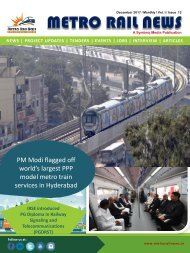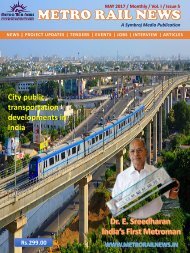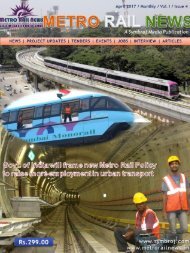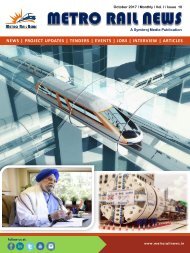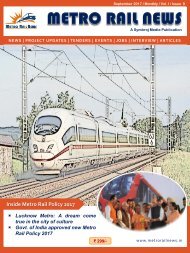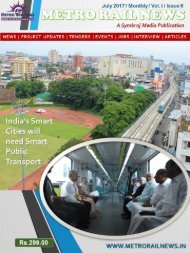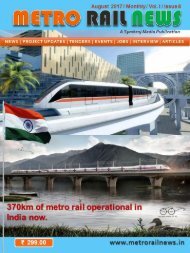Metro Rail News December 2016
Create successful ePaper yourself
Turn your PDF publications into a flip-book with our unique Google optimized e-Paper software.
Small- and medium-sized cities<br />
have a lower income than the<br />
mega cities and thus<br />
dependency on private modes<br />
there is comparatively lesser.<br />
The World Health<br />
Organization (WHO) now<br />
classifies<br />
disability,<br />
unproductive life years, and<br />
premature deaths that are<br />
related to road injuries as a<br />
significant health impact of<br />
motorisation. According to the<br />
Union Ministry of Road<br />
Transport and Highways, close<br />
to 500,000 road accidents were<br />
reported in the year 2012 and<br />
as much as 11 per cent of<br />
global road-injury deaths occur<br />
annually in India alone.<br />
Urban transport reforms have<br />
taken roots in India. The<br />
momentum for this has come<br />
from the national policies as<br />
well as state government<br />
programmes.<br />
With the introduction of a new<br />
mission, 100 smart cities and<br />
500 cities in India will be<br />
rejuvenated and transformed<br />
with an allocation of close to Rs<br />
1 lakh crore, for a period of five<br />
years. The Union Cabinet has<br />
already cleared Prime<br />
Minister Narendra Modi’s pet<br />
projects—smart cities spread<br />
across the country and a new<br />
urban renewal mission named<br />
after Atal Bihari Vajpayee,<br />
replacing the existing one<br />
named after Jawaharlal Nehru.<br />
“Smart city aspirants” will be<br />
selected through a “City<br />
Challenge Competition”<br />
intended to link financing with<br />
the ability of the cities to<br />
perform and achieve the<br />
mission objectives. Each state<br />
will now shortlist a certain<br />
number of “smart city<br />
aspirants” as per the norms<br />
that will be indicated and will<br />
prepare smart city proposals<br />
for further evaluation to seek<br />
support from Centre.<br />
The move is expected to recast<br />
the urban landscape of the<br />
country to make it more<br />
liveable and inclusive but how<br />
do they tend to achieve that as<br />
this is not the first urban<br />
renewal mission launched in<br />
India to improve the urban<br />
infrastructure.<br />
A similar mission was<br />
launched in India in 2006,<br />
known as Jawaharlal Nehru<br />
National Urban Renewal<br />
Mission (JNNURM), and was a<br />
reform driven Central<br />
assistance programme for<br />
development of infrastructure<br />
to provide fast track and<br />
planned development for the<br />
65 targeted cities in India.<br />
Funding was tied to a set of<br />
mandatory and optional<br />
reforms targeted at municipal<br />
governance and sectoral<br />
reforms. It envisaged a total<br />
investment of US $20 billion<br />
over seven years, which is<br />
ARTICLES |<br />
equal to funding in the smart<br />
cities mission.<br />
While the overall JNNURM<br />
reforms had targeted all urban<br />
infrastructure sectors, the<br />
transport sector had hogged<br />
about quarter of the JNNURM<br />
funds. Even though about 30<br />
states and union territories<br />
qualified for the JNNURM<br />
funds, transport sector funding<br />
was allocated majorly to Delhi,<br />
with mega cities bagging the<br />
maximum numbers of projects.<br />
For getting approval for<br />
transport projects, the<br />
guidelines recommend that the<br />
transport infrastructure<br />
improvement schemes should<br />
be in compliance with the<br />
NUTP (National Urban<br />
Transport Policy) that had laid<br />
down the guiding principle for<br />
sustainable mobility with clear<br />
thrust on public transport, nonmotorised<br />
transport, and<br />
transit oriented development.<br />
The project analysis, however,<br />
showed that the identified and<br />
approved projects were not in<br />
sync with the spirit of the<br />
NUTP. The actual spending<br />
has been locked in car centric<br />
infrastructure.<br />
In JNNURM, under the<br />
transportation reforms, the<br />
roads and flyovers category<br />
dominated with as much as 70<br />
per cent of the total number of<br />
projects and 15 per cent were<br />
mass-transit projects.<br />
<strong>Metro</strong> <strong>Rail</strong> <strong>News</strong> | <strong>December</strong> <strong>2016</strong> | www.metrorailnews.in 56






